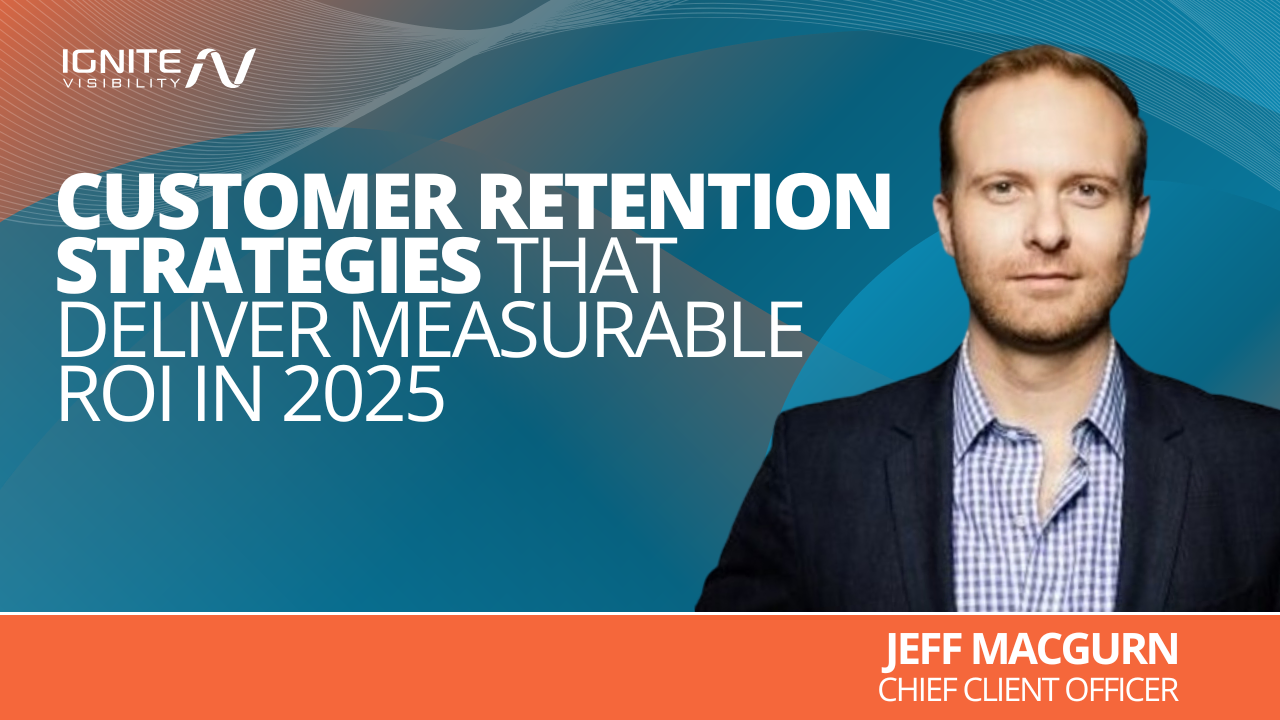
According to a recent study, 73% of American consumers are willing to abandon your brand after just one bad customer experience.
On the other hand, 76% said they would recommend a brand after a great customer experience, and 69% stated they’re willing to pay more for brands that genuinely care about their customers and put in the work to keep them.
If you learn anything from those stats, let it be this: if you aren’t focusing on customer retention strategies, you need to be.
In this article, Jeff MacGurn, Chief Client Officer, will dive into the world of customer retention and give you actionable customer retention strategies that will keep your customers coming back again and again.
What We’ll Cover
- Importance of Customer Retention
- Key Customer Retention Strategies
- Examples of Customer Retention Tactics You Can Implement
- Are My Customer Retention Methods Actually Working?
- Customer Retention Best Practices
- Pitfalls to Avoid
Importance of Customer Retention
Customer retention is all about keeping your current customers happy and coming back for more. It’s like having a loyal fan base that cheers you on.
Unlike constantly chasing new customers, which can be exhausting and expensive, nurturing your existing customers is cost-effective and generally, simpler.
You can use the customer retention rate formula to figure out how well you’re doing. Take the number of customers you have at the end of a specified period and subtract the number of new customers. Take that number and divide it by the total number of customers you had at the beginning. Then multiply that number by 100 to get your customer retention rate.
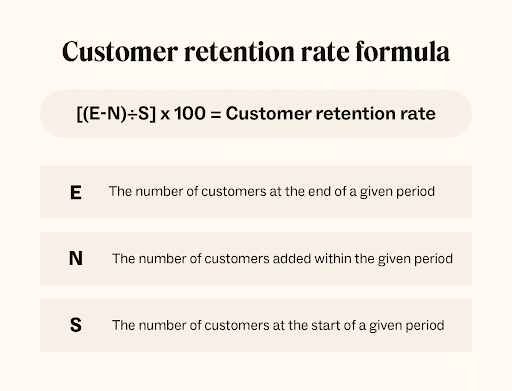
So, why should you prioritize retention? Well, for starters, it’s way cheaper to keep a customer than to acquire a new one. Plus, happy, loyal customers are more likely to spend more over time, boosting your overall revenue. And let’s not forget about word-of-mouth: satisfied customers are your best brand ambassadors.

Customer Retention Over Acquisition
Let’s take a deeper look at the cost-effectiveness of retention over acquisition.
According to the Harvard Business Review, acquiring a new customer can cost between 5-25% more than retaining an existing one. This is due to several reasons, including rising digital advertising costs and growing consumer skepticism toward traditional advertising channels.
Beyond direct acquisition costs, the profitability difference is even more striking. The same Harvard Business Review study shows that increasing customer retention by just 5% can boost profits by between 25% and 95%, depending on the industry. This is because existing customers typically spend 31% more per transaction than new customers and are 50% more likely to try new products or services.
A good customer retention management system is necessary if you want to increase your customer lifetime value. Happy customers have a 306% higher lifetime value and stay with brands for an average of 5.1 years. They bring their friends along as well, with 71% of them recommending brands to their friends.
Our Expert Insight on Customer Retention
Customer retention management is not just about keeping customers from leaving. You want to turn them into raving supporters. Trust me, focusing on your existing customers can be a game-changer.
I’ve seen firsthand how a strong customer retention strategy can take a business from barely surviving to thriving. When you prioritize your current customers, you’re opting to invest in long-term growth and stability. Imagine having a loyal customer base that consistently supports your brand. That’s the power of retention.
That’s why it’s important to put yourself in your customers’ shoes and understand their needs, wants, and pain points. What keeps them coming back? What frustrates them?
Action Item: Take a deep dive into your customer data. Identify your most loyal customers and analyze their behavior. What do they buy? How often do they purchase? What marketing channels do they respond to? Use these insights to create targeted campaigns and personalized experiences.
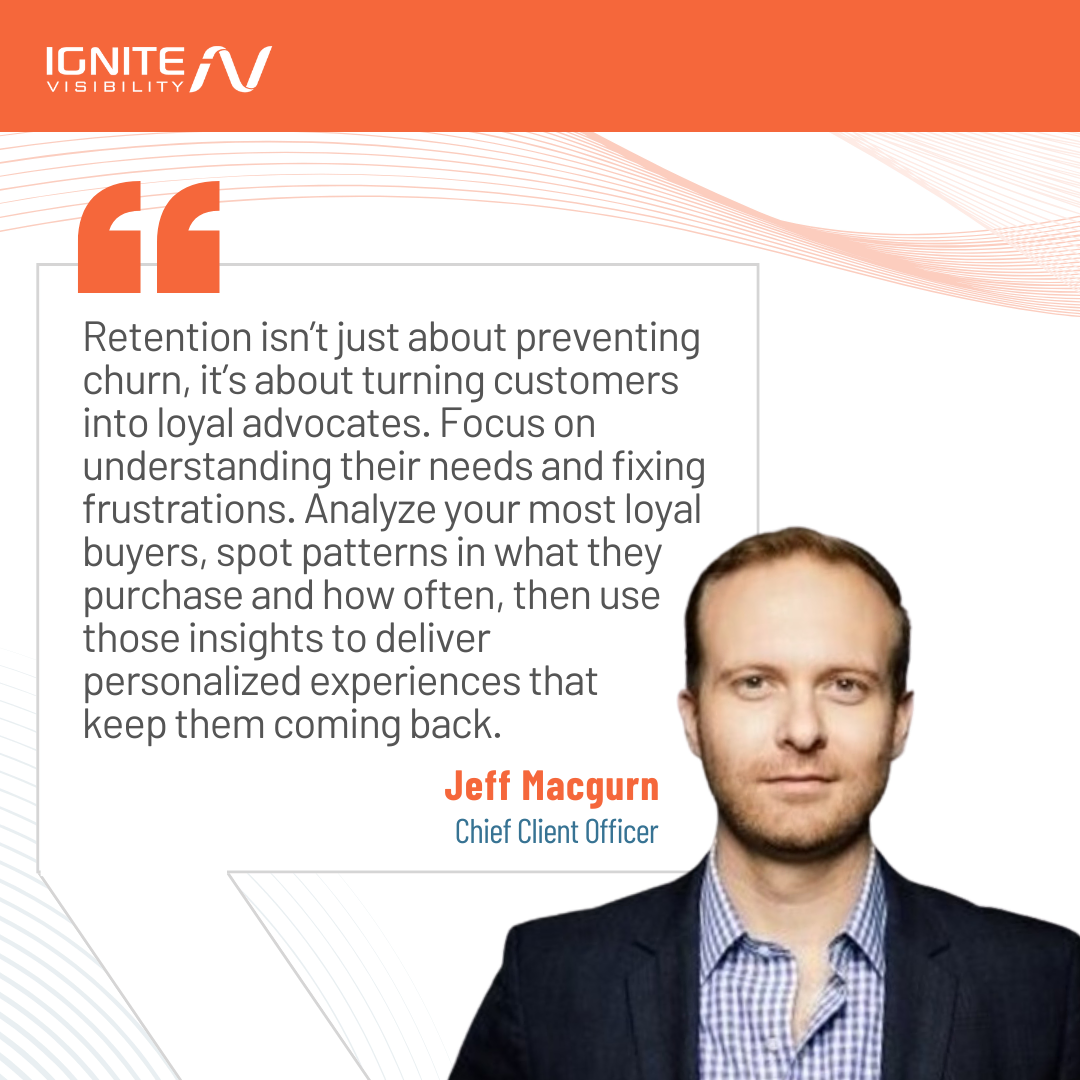
Key Customer Retention Strategies
Now that we’ve got a solid working definition of lifecycle marketing retention, let’s dive into how to increase customer retention in marketplaces. There are tons of tools in your marketing toolbox, and we’re going to explore a few of the most effective ones.
Email and SMS Marketing
Email and SMS are still incredibly powerful for building relationships and keeping customers engaged. The key is to use them strategically and with purpose.
Regular communication is crucial to stay top of mind. But don’t just blast out sales pitches. Offer value with informative content, exclusive offers, or personalized recommendations. Remember, people are more likely to open an email or text if they know it’s worth their time.
For example, a fashion brand might send a text with a limited-time discount code for new subscribers, or an email with styling tips featuring their latest collection.

In-App Messaging
If you have a mobile app, it’s like having a direct line to your customers right in the palm of their hand. Use it to offer personalized recommendations, time-sensitive promotions, or just to say hello.
A well-timed in-app message can significantly boost engagement and retention.
For instance, a food delivery app could suggest new restaurants based on a customer’s past orders or offer a discount on their next order if they haven’t used the app in a while.

Push Notifications
Push notifications can be super effective in bringing customers back to your app or website. But use them wisely! Nobody likes to be bombarded with irrelevant messages.
Focus on delivering valuable information or time-sensitive offers. For example, a news app might send a push notification for breaking news, or a gaming app could alert users about new levels or challenges.

Social Media
Social media is a vibrant community where you can connect with your customers on a more personal level. It’s a great place to share behind-the-scenes content, respond to comments and messages, and run contests or giveaways.
Be authentic, engaging, and responsive. Brands like Patagonia and Dove are masters at using social media to build loyal customer communities.

How to Improve Customer Retention: Examples of Customer Retention Tactics You Can Implement
Tactic #1: Gift-Giving
Whether it’s a gift, a voucher, contest, or a valuable piece of content (ebook, whitepaper, etc.), most people enjoy the experience of getting something for nothing.
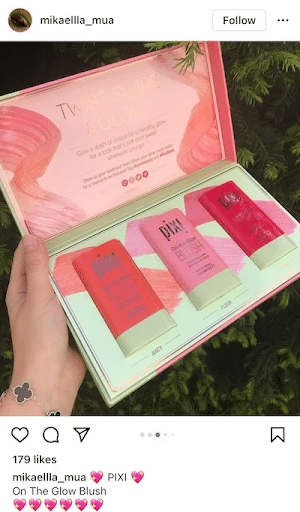
Giveaways and gifts are the perfect customer retention examples that appeal to customers’ sense of “scoring a deal” and convey your company’s generosity—in other words, the type of business that they want to provide services for them.
Tactic #2: Offer Promotions
In 2022, 90% of consumers used at least one coupon. Customers redeeming coupons is good – it means you already have an audience primed to make a purchase if there’s a value-added offer available.
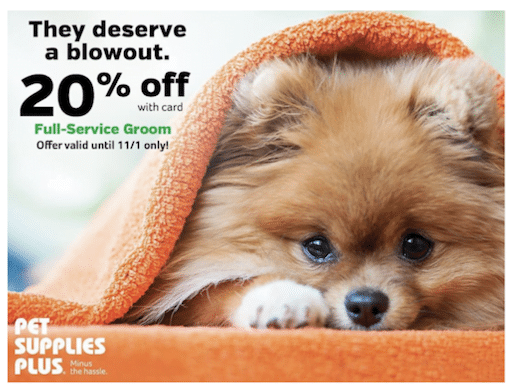
Luckily, there are several ways you can go about this. For example, when shipping a product, you can include a coupon or free shipping code they can use on their next shopping spree. You can even run promotions during off-peak sales periods to entice consumers to stock up for the season.
Tactic #3: Host Customer Events
Getting an invite to an exclusive event is a surefire way to make someone feel special. Therefore, it should come as no surprise that hosting a customer event is one of the best customer retention tactics out there.
Here are a few event ideas that are guaranteed to get your clients to engage with you:
- Learning Event—Here, you want to focus on educating your attendees. Consider a “how-to” webinar session or a refresher on how to use a specific product.
- Product Launch Event— Launching a new product soon? Create some buzz while rewarding your most loyal customers with an invite to a product launch event.
- Charitable Event—What’s better than hosting an event with a noble purpose tied to it? You can retain customers while also helping a worthy cause—a win-win for all.
For ideas on customer events, take a look at the home goods brand, IKEA. Their stores host a variety of customer events. Some are free to everyone, while others are limited to IKEA Family members or Shop & Go App users.
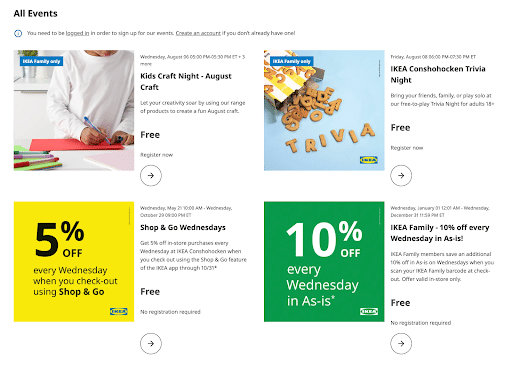
Tactic #4: Only Offer Best-In-Class Customer Service
Providing a seamless customer service experience is one of the best things you can do to boost customer loyalty and retention. Whether users are reaching out to you on-site, through email, or via social media, always be sure to respond!
And don’t forget about SMS! By leveraging automation, you can ensure that your customers get the help they need when they need it.
More often than not, an effectively resolved issue can turn an unhappy customer into a brand loyalist, whereas poor service can drive them to your competitors.
To avoid this situation, make sure you respond to inquiries immediately and go above and beyond the call of duty.

Tactic #5: Implement a Customer Feedback Loop
A customer feedback loop creates a system that allows you to collect, analyze, and distribute customer reviews. You can then use that data to enhance your customer acquisition and retention strategies.
Don’t be shy about asking your customers to participate in focus groups and surveys. The responses will equip your team with ample and relevant information.
Once gathered, analyze your findings by looking for:
- Trends in consumer behavior
- Areas where you can enhance the user experience
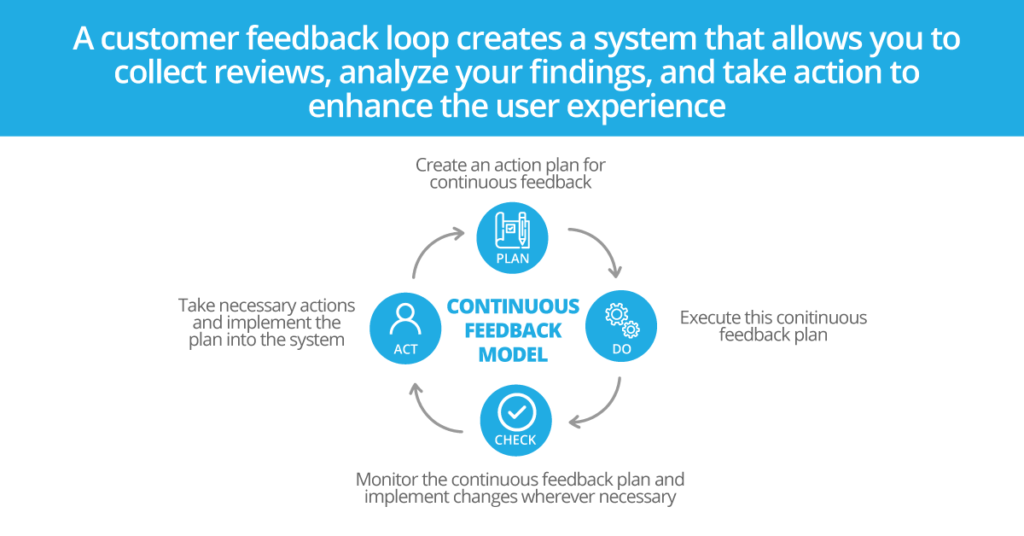
It’s hard to grow your business if you’re unsure of how your customers feel about it. If you don’t already, you need to have a process in place for obtaining that customer feedback so you can share it with the rest of your organization.
Tactic #6: Employing Proactive Service Interventions
Another way to retain your customers is to implement early warning systems that identify at-risk customers before they consider leaving. Use customer management systems and AI tools to identify them based on usage patterns, engagement metrics, and sentiment analysis.
If you think they might leave soon, consider sending them something special, such as a discount or simply checking in. You might be surprised at how many customers you can win back simply by trying.
Tactic #7: Tiered Loyalty Programs
Everyone loves a great loyalty program. Design a multi-level (but easy to navigate!) loyalty program that rewards both shopping frequency and longevity. Set aspirational goals for customers to achieve, inspiring them to continue shopping.
One company that does this well is Ulta Beauty. It starts with a free membership tier. Once a shopper spends $500, they advance to the Platinum tier and unlock additional rewards, including discounts, higher points per dollar, and extra coupons. When they spend $1,200 in a year, they’ll become Diamond members and earn even more rewards.
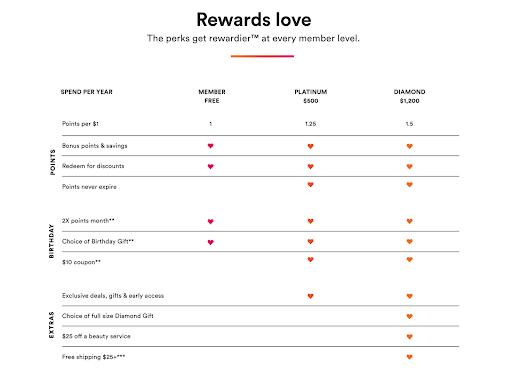
Tactic #8: Personalized Customer Journey Mapping
Customers are craving personalization. Luckily for you, there are numerous ways to create detailed customer journey maps by segment, identifying critical touchpoints and potential drop-off points.
Use this data to boost your customer loyalty and retention by:
- Tailoring messaging to specific needs
- Providing relevant product or service recommendations
- Celebrating customer milestones
- Sending timely communications
- Following up post-purchase
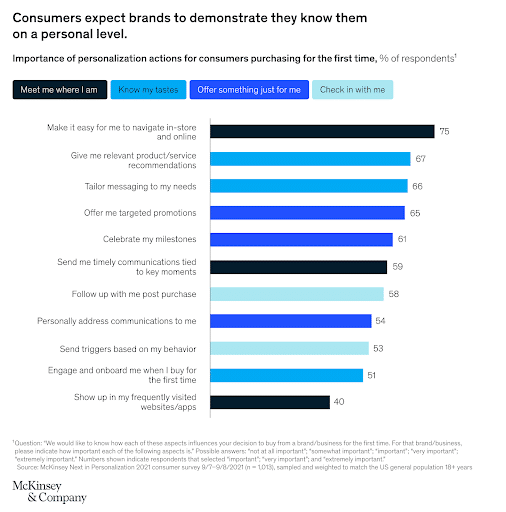
Ways to increase customer retention through personalized actions
Customer Retention Metrics
Now that we’ve covered different strategies and specific tactics to try out, it’s important to cover how to measure the results of your efforts.
Key Metrics to Track
To measure the success of your customer retention efforts, you need the right metrics. Here are a few key ones to watch:
- Customer Retention Rate: This tells you the percentage of customers who continue to do business with you over a specific period.
- Customer Churn Rate: This metric measures the rate at which customers are leaving, representing the opposite of retention.
- Repeat Purchase Rate: How often are your customers coming back for more? A high repeat purchase rate indicates customer satisfaction and loyalty.
- Customer Lifetime Value: This metric predicts the total revenue a customer will generate throughout their relationship with your business. It’s a great way to measure the long-term impact of your retention efforts.
- Net Promoter Score: This measures customer loyalty and satisfaction. It’s a valuable tool for understanding how customers feel about your brand.
- Customer Satisfaction Score (CSAT): This metric measures the level of customer satisfaction with your products or services.
- Customer Effort Score (CES): Your CES measures how easy (or hard!) it is for customers to interact with your business. It’s especially important when resolving an issue.

Tools and Platforms
To track these metrics, you’ll need the right tools. Consider using tools that can help you collect and analyze customer data, such as:
- Customer Relationship Management (CRM) Software: With a CRM, you can track interactions, preferences, purchase history, and more. This data is invaluable for understanding your customers and tailoring your retention efforts. Popular options include Salesforce and HubSpot.
- Email Marketing Platforms: Beyond sending emails, platforms like Mailchimp, HubSpot, and Constant Contact provide insights into how your customers engage with your messages. Open rates, click-through rates, and unsubscribe rates are crucial metrics for measuring email campaign effectiveness. Many of these platforms offer built-in analytics to measure email performance and customer engagement.
- Analytics tools: To understand your website visitors and customers on a deeper level, analytics tools are indispensable. They provide insights into website traffic, user behavior, and conversion rates. Platforms like Google Analytics are indispensable.
The key is to integrate your retention tracking with your overall marketing analytics. This will give you a holistic view of your customer journey and help you identify areas for improvement.
Customer Retention Best Practices
Alright, let’s talk about how to make these strategies really work for your business. It’s all about the details.
Personalization & Segmentation
Personalization shows them you care and understand their needs. Imagine receiving an email with product recommendations tailored to your taste – pretty cool, right?
To make personalization happen, you need to segment your audience. Think of it like sorting your friends into groups based on shared interests. By grouping your customers based on similar behaviors, preferences, or demographics, you can deliver more relevant messages.

Consistent & Relevant Communication
Consistency is key. You want your brand voice to be recognizable across all channels by having a signature style that people associate with you. Whether it’s your email, social media, or in-app messages, make sure your tone and messaging are aligned.
Beyond consistency, the content you share needs to be relevant and valuable. Nobody wants to be bombarded with irrelevant information. Offer something that genuinely interests your customers, whether it’s informative articles, exclusive discounts, or behind-the-scenes content.

Feedback & Continuous Improvement
The beauty of customer relationships is that they’re always evolving. What worked yesterday might not work tomorrow. That’s why it’s crucial to gather feedback and use it to improve your retention strategies.
Surveys, reviews, and social media comments are goldmines of information. Pay attention to what your customers are saying. Are they happy? Frustrated? What do they want more of? Use this feedback to make data-driven improvements. Remember, the journey to perfect customer retention never ends. It’s about constant learning and adaptation.

Pitfalls to Avoid
Building a strong customer retention strategy is great, but it’s equally important to know what not to do. Let’s talk about some common pitfalls that can sabotage your efforts.
Neglecting Existing Customers – It’s easy to get caught up in chasing new customers, but don’t forget about the ones you already have. These are the people who believe in your brand. Neglecting them is disrespectful and can lead to lost business.
Inconsistent Communication – Customers appreciate consistency. Don’t send out emails one week and then go radio silent for a month. Establish a regular communication schedule and stick to it.
Lack of Personalization – Generic, mass-produced messages can come across as impersonal and insincere. Take the time to understand your customers and tailor your communications to their specific needs and preferences.
Avoiding these pitfalls will help you build stronger, more lasting relationships with your customers.
Boost Your Bottom Line with Ignite Visibility
Improving your customer retention rate is essential for business growth. By implementing effective customer retention strategies, you can increase customer lifetime value, reduce customer acquisition costs, and foster brand loyalty.
Ignite Visibility can help you:
- Develop a comprehensive customer retention strategy
- Execute targeted email and SMS campaigns
- Optimize your in-app messaging and push notifications
- Leverage social media for customer engagement
- And much more!
Ready to transform your customer retention? Contact us today!

